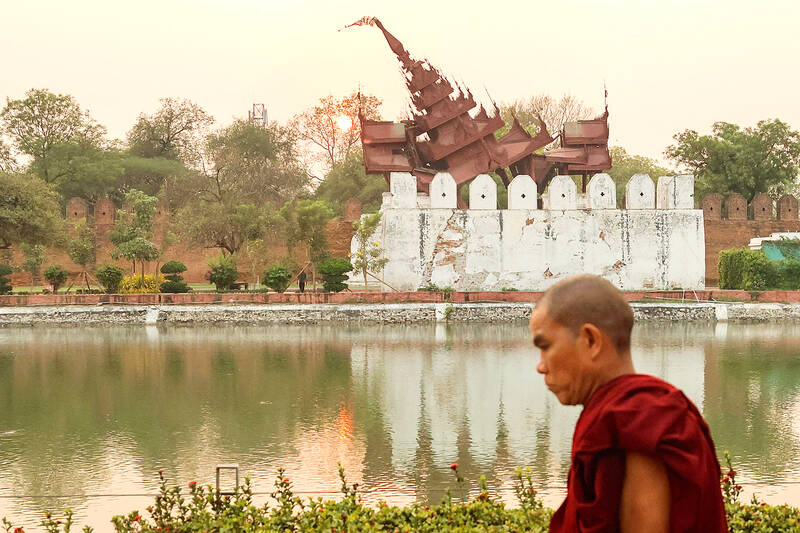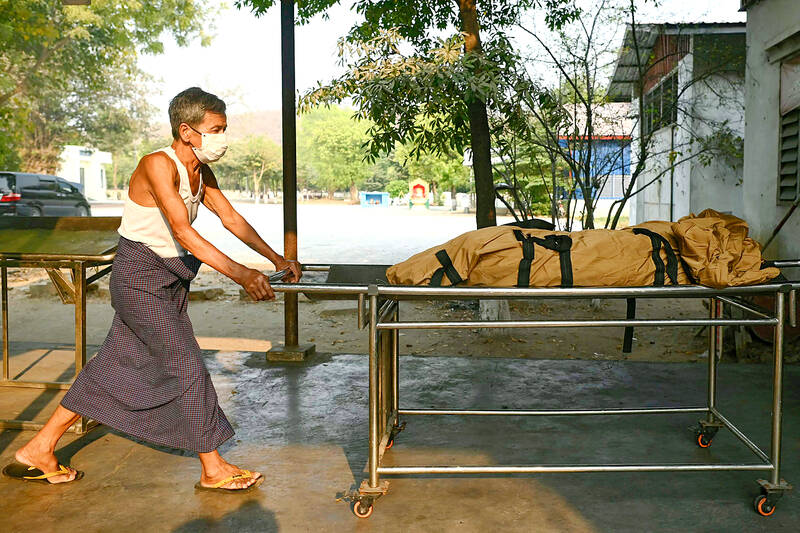The baby was born in the aftermath of Myanmar’s earthquake and given to the flames of Buddhist funeral rites two days later, too young to have been named.
The child’s pregnant mother was knocked over by the force of the quake while working in a paddy field, said grandmother Khin Myo Swe, and gave birth the following day.
The baby was brought to a hospital in Mandalay to be incubated, but died on Monday.

Photo: AFP
“We are all living in hardship,” wept Khin Myo Swe as an ambulance worker gently cradled the little body before a Buddha statue decorated with flowers, then took it away to be cremated.
Three days after a 7.7-magnitude earthquake struck central Myanmar the death toll has hit 2,056, with more still buried in the remnants of ruined buildings in the nation’s second city.
Since the quake hit Friday, ambulances have been bringing the remains of the dead to the crematorium in the Kyar Ni Kan neighborhood on the outskirts of Mandalay.

Photo: AFP
‘WHAT OTHERS CANNOT’
Some 300 bodies have been delivered in total, more than 100 on Sunday alone, forcing them to work six hours beyond their usual closing time.
Some vehicles peel in with frenzied haste. A crew of men say they are bringing a 16-year-old female quake victim.
The bundle of cloth they deposit before the crematorium’s sliding metal door is much shorter than a typical teenage girl and one man retches as they bundle back in the van.
They do not speak as they leave the crematorium lot — eager to ferry her clothing home to bring her soul back to her family.
Nay Htet Lin, the head of another four-man crew who have brought in around 80 bodies since the quake, said: “On the first day of the earthquake, we helped injured people get to hospital. On the second day, we had to carry only dead bodies.”
CLEANSING FIRE
Cremation is a core tenet of the Buddhist faith, with adherents believing it frees the soul from the body and facilitates rebirth in a new life.
In some Asian cultures, those who deal with the dead are regarded as outcasts, on the margins of society.
But Nay Htet Lin said it was “noble work.”
“We are doing what other people cannot,” he said. “We will have a good next life.”
One 15-year veteran crematorium staffer had no regrets over his choice of workplace, even as he witnessed a parade of anguish.
“Everyone is coming here with their sad feelings, with their suffering,” said the 43-year-old, asking for anonymity as he was not authorized to speak to the media. “When they come here I also work for them.”
FOOD OFFERING
Much of the focus of rescue teams has been in urban Mandalay where apartment complexes have been flattened, a Buddhist religious complex eviscerated and hotels crumpled and twisted into ruins. At some disaster sites the smell of rotting bodies is unmistakable.
Khin Myo Swe’s short-lived grandchild was the 39th body delivered on Monday. She said the baby’s mother had not yet been told of her child’s death. It costs less than US$3 at free-market rates to cremate an adult in the diesel-fueled facility, and half that for an infant.
“I had to lie to my daughter, telling her I left the baby in hospital,” said Khin Myo Swe, 49.
“If I tell her now I’m worried the shock would kill her too. I will send food as an offering to the monastery for the baby’s soul.”

That US assistance was a model for Taiwan’s spectacular development success was early recognized by policymakers and analysts. In a report to the US Congress for the fiscal year 1962, former President John F. Kennedy noted Taiwan’s “rapid economic growth,” was “producing a substantial net gain in living.” Kennedy had a stake in Taiwan’s achievements and the US’ official development assistance (ODA) in general: In September 1961, his entreaty to make the 1960s a “decade of development,” and an accompanying proposal for dedicated legislation to this end, had been formalized by congressional passage of the Foreign Assistance Act. Two

Despite the intense sunshine, we were hardly breaking a sweat as we cruised along the flat, dedicated bike lane, well protected from the heat by a canopy of trees. The electric assist on the bikes likely made a difference, too. Far removed from the bustle and noise of the Taichung traffic, we admired the serene rural scenery, making our way over rivers, alongside rice paddies and through pear orchards. Our route for the day covered two bike paths that connect in Fengyuan District (豐原) and are best done together. The Hou-Feng Bike Path (后豐鐵馬道) runs southward from Houli District (后里) while the

March 31 to April 6 On May 13, 1950, National Taiwan University Hospital otolaryngologist Su You-peng (蘇友鵬) was summoned to the director’s office. He thought someone had complained about him practicing the violin at night, but when he entered the room, he knew something was terribly wrong. He saw several burly men who appeared to be government secret agents, and three other resident doctors: internist Hsu Chiang (許強), dermatologist Hu Pao-chen (胡寶珍) and ophthalmologist Hu Hsin-lin (胡鑫麟). They were handcuffed, herded onto two jeeps and taken to the Secrecy Bureau (保密局) for questioning. Su was still in his doctor’s robes at

Mirror mirror on the wall, what’s the fairest Disney live-action remake of them all? Wait, mirror. Hold on a second. Maybe choosing from the likes of Alice in Wonderland (2010), Mulan (2020) and The Lion King (2019) isn’t such a good idea. Mirror, on second thought, what’s on Netflix? Even the most devoted fans would have to acknowledge that these have not been the most illustrious illustrations of Disney magic. At their best (Pete’s Dragon? Cinderella?) they breathe life into old classics that could use a little updating. At their worst, well, blue Will Smith. Given the rapacious rate of remakes in modern